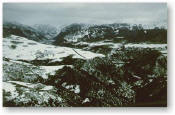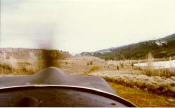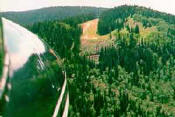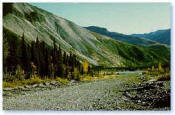MUST KNOW INFORMATION
Minimum Knowledge for Mountain Flying
NOTICE: The following is a summation of the minimum knowledge areas needed to fly safely in the mountains. Further study and instruction (from a knowledgeable instructor) are required prior to flying the mountains. This minimum knowledge information is intended to supplement, not replace, your preparation for flying in the mountains.

Mountain Flying Safety Rule – Never maneuver the
airplane
into a position where it has the opportunity to crash.
BASIC PREMISES
Although there are a myriad of procedures and techniques for operating in the mountains, there is only one basic aphorism that guarantees your safety. That basic truism for mountain flying is: Stay in a position to turn to lowering terrain.
The idea that you will always remain in a position where you can turn the airplane toward lowering terrain also encompasses the idea that you will not fly in an area where there is not room to turn around, for example, in a narrow canyon, or when flying upslope terrain.
Incorporated within this basic premise is another truth: Do not fly beyond the point of no return. This isn't a separate rule ... because if you stay in a position to turn to lowering terrain you would never fly beyond the point of no return. But it is often easier to think of it separately to insure an adequate understanding.
Without exception, you must adhere to the two basic premises of mountain flying, whether flying "with the mountains" or over the mountains.
- Always remain in a position where you can turn toward lowering terrain
The novice mountain pilot should plan to fly 2,000 feet above the terrain along the route of flight. When approaching within ½ to ¼ mile from the mountain ridges, turn to approach the ridge at a 45-degree angle. This permits an easy escape with less stress on the airplane if downdrafts or turbulence are encountered. Never fly in a canyon where there is not room to turn around.
- Never fly beyond the point of no return.
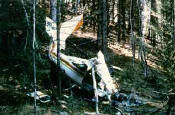 The
point-of-no-return is defined as the point on the ground of rising
terrain where the terrain out climbs the aircraft due to the plan'es
performance limitations. When advocating that you never fly beyond
the point-of-no-return you might find this statement ambiguous. What
is the measuring stick?
The
point-of-no-return is defined as the point on the ground of rising
terrain where the terrain out climbs the aircraft due to the plan'es
performance limitations. When advocating that you never fly beyond
the point-of-no-return you might find this statement ambiguous. What
is the measuring stick?
TURN-AROUND POINT
Of more importance to the pilot than the point-of-no-return is the turn-around point. These two terms are often interchanged. The turn-around point is the position where, if the throttle is reduced to idle, the aircraft can be turned around during the resulting glide without impacting the terrain.
Flying beyond the "point-of-no-return" will lead to an accident.
Okay, got that. But where is this elusive turn-around point position? When the airplane is being flown toward rising terrain and it reaches a position that is about 500-feet AGL, it's time to turn around.
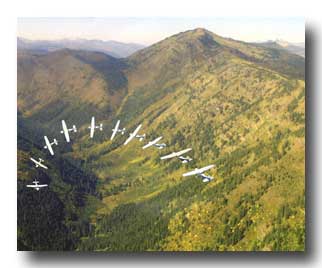 Make
all turns away from the mountain and maneuver to gain additional
altitude before continuing the flight toward the rising terrain. If
the wind if blowing sufficiently to provide mechanical lift, it is
advantageous to make a figure-8 pattern along the side of the
mountain to take advantage of the lift.
Make
all turns away from the mountain and maneuver to gain additional
altitude before continuing the flight toward the rising terrain. If
the wind if blowing sufficiently to provide mechanical lift, it is
advantageous to make a figure-8 pattern along the side of the
mountain to take advantage of the lift.
BEYOND THE POINT-OF-NO-RETURN
Flying beyond the point-of-no-return often creates a "world of hurt" for the pilot (and the airplane). Once the airplane is maneuvered further than this point there are only two option available ... unfortunately they both result in an accident.
-
The first option, usually the best, is to land straight ahead into whatever inhospitable terrain exists. This is difficult to do, especially with rising terrain. You are going to pull back on the control wheel to avoid the terrain; however, with a strong will and constitution the pilot determined to survive will lower the nose and maintain the airspeed until pretending to land at an international airport ... regardless of what lies ahead. Failure to do so may result in a stall. The human body can withstand something like 40 Gs of lateral force during a deceleration, but only about 6-8 Gs of compression force from a stall. Don't stall.
-
The second option is a frantic attempt as self preservation that just doesn't work. The pilot tries to turn around without sufficient lateral area (in a canyon) or without sufficient altitude to do so. Seeing that there isn't enough room to turn around the pilot steps on the "bottom" rudder (left rudder in a left turn; right rudder in a right turn) to hurry the turn, usually causing a tuck-under spin entry. Here it doesn't matter how good you are, or how good you think you are; you've just lost a minimum of 400 feet during the attempted recovery.
Survival is better suited by landing straight ahead. This should never become an issue when you are conditioned to stay in a position to turn to lowering terrain. This conditioning is a process I call "mountology."
MOUNTOLOGY
Instinct in an airplane is often wrong. For example, when a pilot finds himself in his first spin, the natural response is to pull back on the control wheel to raise the nose. It's always worked before. But now the airplane is in a stall with an ineffective elevator. To make the elevator effective, break the stall and fly out of the resulting dive. This, like the basic axioms of mountain flying, is a conditioned response.
Mountology is a neologism, that is, my contrived word that describes the conditioned response to the basic premises of mountain flying.
Conditioned in psychology means exhibiting or trained to exhibit a conditioned reflex or response. Training is the key word. Reflex means an unlearned or instinctive response to a stimulus. And instinct means an innate aspect of behavior that is unlearned, complex and normally adaptive.
Mountology means your flight through the mountains will keep you in a position to escape without constantly thinking about it. This conditioning takes time and effort, that is, practice with an experienced mountain pilot. It is not something you go out and do once or twice and figure you have "it." But it is something you can be aware of so that you condition yourself. Keep repeating a mantra to yourself, "Stay in a position to turn to lower terrain," while constantly evaluating the flight situation.
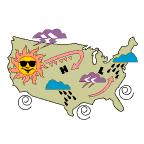
MOUNTAIN
METEOROLOGY
A complete check of the weather is necessary to develop a go/no-go decision. Stay out of marginal weather areas. Winds aloft greater than 30 knots at cruise altitude usually means the novice pilot should delay or postpone the flight until more favorable conditions prevail.
|
Airport
(TEX) at Telluride, Colorado, perched 1,000 feet DENSITY ALTITUDEDensity altitude is the altitude the airplane thinks it is at and performs in accordance with. High, hot and humid conditions may raise the effective physical altitude of an airstrip to a performance altitude many thousands of feet higher than its actual elevation. RUNWAY LENGTHA handy rule-of-thumb for operating from a short runway is that if you obtain 70 percent of the speed necessary for rotation at the halfway point of the runway, you can take off in the remaining distance. Note: This rule of thumb guarantees takeoff performance, but not rate-of-climb after the takeoff. LEANING THE MIXTUREFor density altitudes of 3,000 feet or greater, lean the mixture for takeoff according to the airplane manufacturer's recommendation. Do not lean turbocharged or supercharged engines for takeoff. Lacking any recommendation, lean the mixture during the takeoff roll slowly until encountering engine roughness, then enrich for engine smoothness. APPROACH RIDGESTurn to approach ridges at a 45-degree angle to provide you the option of escaping toward lowering terrain. Begin this turn to approach the ridge at the 45-degree angle when you are about 1/2 to 1/4 mile from the ridge. The visual aspects of mountain flying can be deceiving, but if you can see more and more of the terrain on the other side of the ridge you are approaching, you are higher than the ridge and can probably continue. As you near the ridge, arriving at a position where the power can be reduced to idle and the airplane will glide to the top of the ridgeline, a commitment to cross the ridge can be made. At this position, the airplane is close enough to the ridgeline not to experience an unexpected downdraft of a nature that will cause a problem. If a downdraft is encountered, keep the power on, lower the nose to maintain airspeed and the airplane will clear the ridge. FLYING CANYONSUntil you have the experience of flying canyons with a knowledgeable instructor, do not fly up canyons. If it is necessary to fly in a canyon, gain altitude, fly to the head of the canyon, then fly downslope terrain. AIRSPEED CONTROLLanding at a short mountain strip requires exact airspeed control to eliminate float. A 10-percent increase in the proper approach speed results in a 21-percent increase in landing distance. Use the same indicated airspeed for approach when landing at a high-elevation mountain strip that you would use for the approach at a sea level airport. The thin air at high altitudes affects the airspeed indicator. A rule-of-thumb states that the airplane flies faster than indicated airspeed at altitudes above sea level by approximately 2-percent-per-thousand feet above sea level. This is a built-in compensator for reduced lift caused by the thin air at higher altitude airports.
|
 |
|
Allow a minimum of an extra half hour of daylight if your destination is a mountain strip without runway lighting. There may be plenty of daylight at cruise altitude, but darkness may exist because of shadows at the valley destination.
Landing at Possum Creek airstrip, 10,010-foot elevation.
See
"You're
Landing Where?" and
"Possum
Creek"
page for more information
GROSS WEIGHT
The takeoff distance varies with the gross weight. A 10-percent increase in the takeoff gross weight (while not exceeding the maximum allowable gross weight) will cause a:
|
|
5-percent increase in the speed necessary for takeoff; |
|
|
9-percent decrease in acceleration to takeoff speed, and |
|
|
21-percent increase in the takeoff distance. |
CLIMB OUT
The first consideration for takeoff from a strip surrounded by mountains is terrain clearance. A considerable amount of time may be required to circle, climbing to the en route altitude prior to turning on course.
DOWNDRAFTS
Use visualization to determine possible downdraft areas. Air behaves like water. Ask yourself, "What would water do if it were flowing like the winds aloft?"
You can then picture areas of downdrafts, updrafts and splashes of turbulence.
If you encounter unexpected downdrafts, diving–away from the visualized downdraft–to maintain airspeed will generally lessen the total displacement effect of the downdraft (altitude loss). Although the rate of descent is greater at the higher airspeed, you will be under the influence of the sink for a shorter period of time.
COURSE REVERSAL
Everyone flying in the mountains will encounter situations when it becomes necessary to make a 180-degree turn. Forget hammerhead turns, wingovers, chandelles and the other fancy maneuvers. By the time you figure out you are in trouble and need to turn around, there is insufficient speed to perform these maneuvers.
To turn around, slow down. This will decrease the radius of turn. Pull back on the control wheel to trade airspeed for altitude if you have extra speed. Then make the steepest turn you can comfortably make, up to 60 degrees.
Airstrip (creek bed) west of Mt. Blackburn, Alaska. You
don't make the standard left-turn departure here.
ARRIVAL
The mountainous terrain surrounding many air strips prevents a normal descent from cruise altitude to pattern altitude. It is necessary to make progressive power reductions to prevent thermal stresses from being induced in the engine. This allows the engine to cool slowly, preventing not only thermal shock, but also preventing de-tuning. Always make smooth power changes when adding or reducing power.
CAUTION: This is not the total information you need to fly safely in the mountains. It is merely an outline of the minimum information that should be studied.
|
|
|



